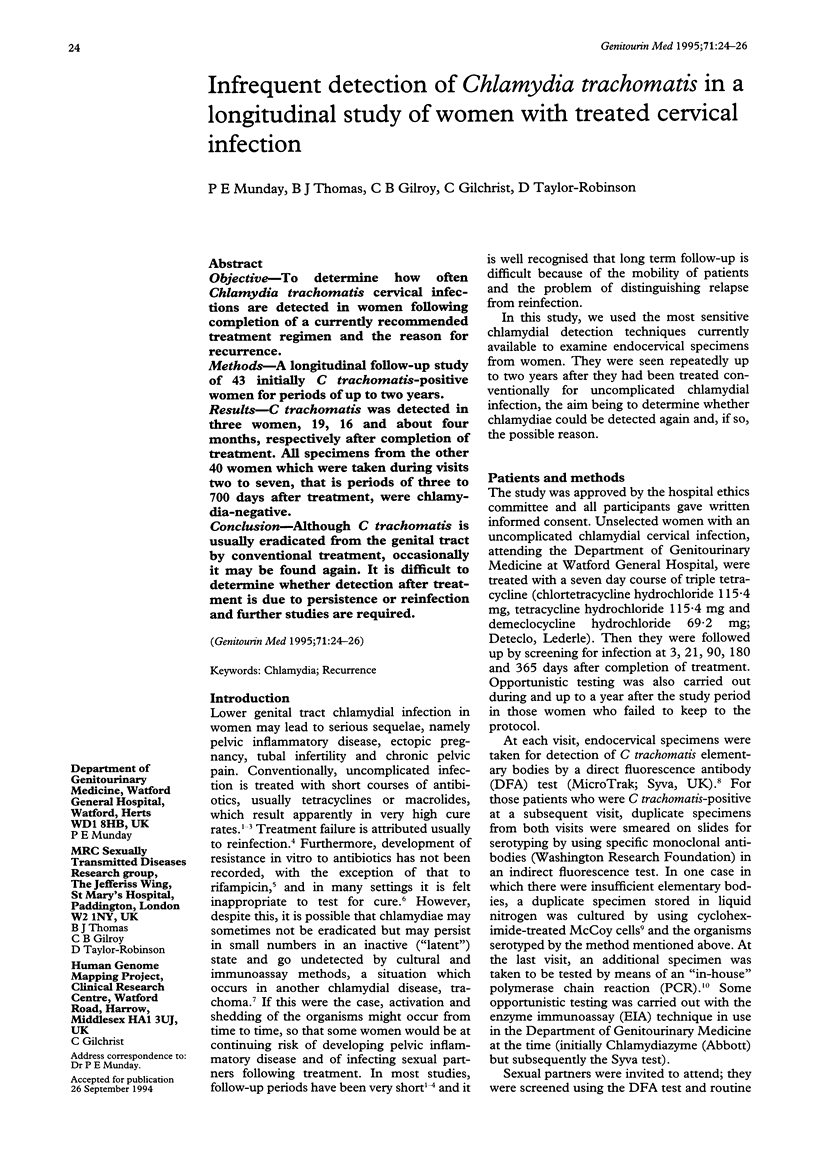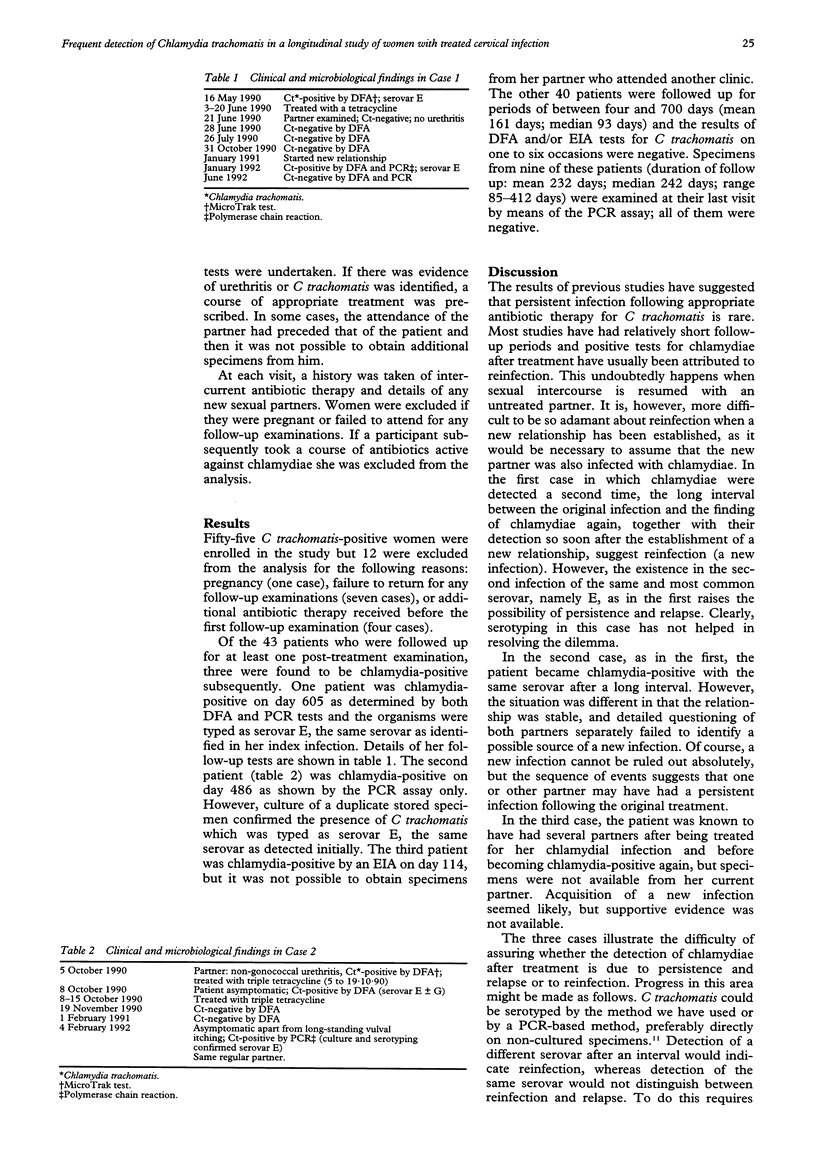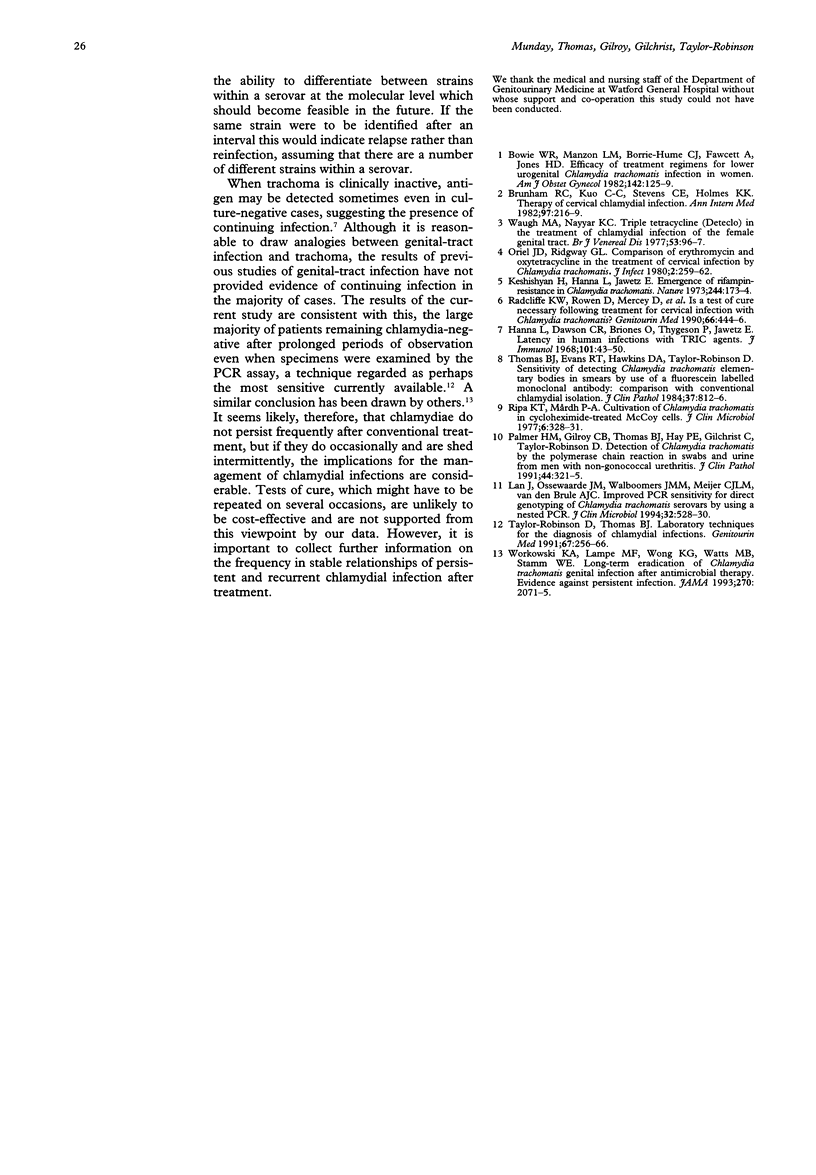Abstract
OBJECTIVE--To determine how often Chlamydia trachomatis cervical infections are detected in women following completion of a currently recommended treatment regimen and the reason for recurrence. METHODS--A longitudinal follow-up study of 43 initially C trachomatis-positive women for periods of up to two years. RESULTS--C trachomatis was detected in three women, 19, 16 and about four months, respectively after completion of treatment. All specimens from the other 40 women which were taken during visits two to seven, that is periods of three to 700 days after treatment, were chlamydia-negative. CONCLUSION--Although C trachomatis is usually eradicated from the genital tract by conventional treatment, occasionally it may be found again. It is difficult to determine whether detection after treatment is due to persistence or reinfection and further studies are required.
Full text
PDF


Selected References
These references are in PubMed. This may not be the complete list of references from this article.
- Bowie W. R., Manzon L. M., Borrie-Hume C. J., Fawcett A., Jones H. D. Efficacy of treatment regimens for lower urogenital Chlamydia trachomatis infection in women. Am J Obstet Gynecol. 1982 Jan 15;142(2):125–129. doi: 10.1016/s0002-9378(16)32325-0. [DOI] [PubMed] [Google Scholar]
- Brunham R. C., Kuo C. C., Stevens C. E., Holmes K. K. Therapy of cervical chlamydial infection. Ann Intern Med. 1982 Aug;97(2):216–219. doi: 10.7326/0003-4819-97-2-216. [DOI] [PubMed] [Google Scholar]
- Hanna L., Dawson C. R., Briones O., Thygeson P., Jawetz E. Latency in human infections with TRIC agents. J Immunol. 1968 Jul;101(1):43–50. [PubMed] [Google Scholar]
- Keshishyan H., Hanna L., Jawetz E. Emergence of rifampin-resistance in Chlamydia trachomatis. Nature. 1973 Jul 20;244(5412):173–174. doi: 10.1038/244173a0. [DOI] [PubMed] [Google Scholar]
- Lan J., Ossewaarde J. M., Walboomers J. M., Meijer C. J., van den Brule A. J. Improved PCR sensitivity for direct genotyping of Chlamydia trachomatis serovars by using a nested PCR. J Clin Microbiol. 1994 Feb;32(2):528–530. doi: 10.1128/jcm.32.2.528-530.1994. [DOI] [PMC free article] [PubMed] [Google Scholar]
- Oriel J. D., Ridgway G. L. Comparison of erythromycin and oxytetracycline in the treatment of cervical infection by Chlamydia trachomatis. J Infect. 1980 Sep;2(3):259–262. doi: 10.1016/s0163-4453(80)90722-7. [DOI] [PubMed] [Google Scholar]
- Palmer H. M., Gilroy C. B., Thomas B. J., Hay P. E., Gilchrist C., Taylor-Robinson D. Detection of Chlamydia trachomatis by the polymerase chain reaction in swabs and urine from men with non-gonococcal urethritis. J Clin Pathol. 1991 Apr;44(4):321–325. doi: 10.1136/jcp.44.4.321. [DOI] [PMC free article] [PubMed] [Google Scholar]
- Radcliffe K. W., Rowen D., Mercey D. E., Mumtaz G., Ridgway G. L., Robinson A. J., Bingham J. S. Is a test of cure necessary following treatment for cervical infection with Chlamydia trachomatis? Genitourin Med. 1990 Dec;66(6):444–446. doi: 10.1136/sti.66.6.444. [DOI] [PMC free article] [PubMed] [Google Scholar]
- Ripa K. T., Mårdh P. A. Cultivation of Chlamydia trachomatis in cycloheximide-treated mccoy cells. J Clin Microbiol. 1977 Oct;6(4):328–331. doi: 10.1128/jcm.6.4.328-331.1977. [DOI] [PMC free article] [PubMed] [Google Scholar]
- Taylor-Robinson D., Thomas B. J. Laboratory techniques for the diagnosis of chlamydial infections. Genitourin Med. 1991 Jun;67(3):256–266. doi: 10.1136/sti.67.3.256. [DOI] [PMC free article] [PubMed] [Google Scholar]
- Thomas B. J., Evans R. T., Hawkins D. A., Taylor-Robinson D. Sensitivity of detecting Chlamydia trachomatis elementary bodies in smears by use of a fluorescein labelled monoclonal antibody: comparison with conventional chlamydial isolation. J Clin Pathol. 1984 Jul;37(7):812–816. doi: 10.1136/jcp.37.7.812. [DOI] [PMC free article] [PubMed] [Google Scholar]
- Workowski K. A., Lampe M. F., Wong K. G., Watts M. B., Stamm W. E. Long-term eradication of Chlamydia trachomatis genital infection after antimicrobial therapy. Evidence against persistent infection. JAMA. 1993 Nov 3;270(17):2071–2075. [PubMed] [Google Scholar]


